
- Media library
- Question limits
- Creating a survey from MS Word doc
- How to edit live surveys
- Survey blocks
- Survey block randomizer
- Question randomization
- Scale Library
- What is monadic testing?
- What is sequential monadic testing?
- Extraction Support for Image Chooser Question Types
- What is comparison testing?
- Custom validation messages
- Survey Builder with QuestionPro AI
- Testing Send
- Survey Preview Options
- Add Questions From a Document
- Survey Authoring 2025
- Standard question types
- Multiple choice question type
- Text question- comment box
- Matrix multi-point scales question type
- Rank order question
- Smiley-rating question
- Image question type
- reCAPTCHA question type
- Net Promoter Score question type
- Van Westendorp's price sensitivity question
- Choice modelling questions
- Side-By-Side matrix question
- Homunculus question type
- Predictive answer options
- Presentation text questions
- Multiple choice: select one
- Multiple choice: select many
- Page timer
- Contact information question
- Matrix multi-select question
- Matrix spreadsheet question
- Closed card sorting question
- Flex Matrix
- Text Slider Question Type
- Graphical Rating Scales
- Rank Order - Drag and Drop
- Bipolar Matrix - Slider
- Bipolar Matrix Likert Scale
- Gabor Granger
- Verified Digital Signature
- Star Rating Question Type
- Push to social
- Attach Upload File Question
- Constant Sum Question
- Video Insights
- Platform connect
- Communities Recruitment
- TubePulse
- Open Card Sorting
- Map Question Type
- LiveCast
- Answer type
- Reorder questions
- Question tips
- Text box next to question
- Text question settings
- Adding other option
- Matrix question settings
- Image rating question settings
- Scale options for numeric slider question
- Constant sum question settings
- Setting default answer option
- Exclusive option for multiple choice questions
- Validate question
- Bulk validation settings
- Remove validation message
- Question separators
- Question Code
- Page breaks in survey
- Survey introduction with acceptance checkbox
- RegEx Validation
- Question Library
- Embed Media
- Slider Start Position
- Answer Display - Alternate Flip
- Matrix - Auto Focus Mode
- Text validations
- Numeric Input Settings- Spreadsheet
- Answer Groups
- Hidden Questions
- Decimal Separator Currency Format
- Allow Multiple Files - Attache/Upload Question Type
- Text box - Keyboard input type
- Deep Dive
- Answer Display Order
- Alternate colors
- Conjoint Best Practices
- Multi-media file limits
- Conjoint Prohibited Pairs
- Add logo to survey
- Custom Themes
- Display Settings
- Auto-advance
- Progress bar
- Automatic question numbering option
- Enabling social network toolbar
- Browser Title
- Print or export to PDF, DOC
- Survey Navigation Buttons
- Accessible Theme
- Back and Exit Navigation Buttons
- Focus Mode
- Survey Layout
- Survey Layout - Visual
- Telly Integration
- Telly Integration
- Workspace URL
- Classic Layout
- Branching - Skip Logic
- Compound Branching
- Compound or delayed branching
- Response Based Quota Control
- Dynamic text or comment boxes
- Extraction logic
- Show or hide question logic
- Dynamic show or hide
- Scoring logic
- Net promoter scoring model
- Piping text
- Survey chaining
- Looping logic
- Branching to terminate survey
- Logic operators
- Selected N of M logic
- JavaScript Logic Syntax Reference
- Block Flow
- Block Looping
- Scoring Engine: Syntax Reference
- Always Extract and Never Extract Logic
- Matrix Extraction
- Locked Extraction
- Dynamic Custom Variable Update
- Advanced Randomization
- Custom Scripting Examples
- Survey Logic Builder - AI
- Custom Scripting - Custom Logic Engine Question
- Survey settings
- Save & continue
- Anti Ballot Box Stuffing (ABBS) - disable multiple responses
- Deactivate survey
- Admin confirmation email
- Action alerts
- Survey timeout
- Finish options
- Spotlight report
- Print survey response
- Search and replace
- Survey Timer
- Allowing multiple respondents from the same device
- Text Input Size Settings
- Admin Confirmation Emails
- Survey Close Date
- Respondent Location Data
- Review Mode
- Review, Edit and Print Responses
- Geo coding
- Dynamic Progress Bar
- Response Quota
- Age Verification
- Tools - Survey Options
- Live survey URL
- Customize survey URL
- Create email invitation
- Personalizing emails
- Email invitation settings
- Email list filter
- Survey reminders
- Export batch
- Email status
- Spam index
- Send surveys via SMS
- Phone & paper
- Adding responses manually
- SMS Pricing
- Embedding Question In Email
- Deleting Email Lists
- Multilingual Survey Distribution
- SMTP
- Reply-To Email Address
- Domain Authentication
- Email Delivery Troubleshooting
- QR Code
- Email Delivery and Deliverability
- Survey Dashboard - Report
- Overall participant statistics
- Dropout analysis
- Pivot table
- Turf analysis
- Trend analysis
- Correlation analysis
- Survey comparison
- Gap analysis
- Mean calculation
- Weighted mean
- Cluster Analysis
- Dashboard filter
- Download Options - Dashboard
- HotSpot analysis
- Heatmap analysis
- Weighted Rank Order
- Cross-Tabulation Grouping Answer Options
- A/B Testing in QuestionPro Surveys
- Data Quality
- Data Quality Terminates
- Matrix Heatmap Chart
- Column proportions test
- Response Identifier
- TURF Reach Analysis
- Bulk Edit System Variables
- Weighting and balancing
- Conjoint analysis designs
- Conjoint part worths calculation
- Conjoint calculations and methodology
- Conjoint attribute importance
- Conjoint profiles
- Market segmentation simulator
- Conjoint brand premium and price elasticity
- What is MaxDiff scaling
- MaxDiff settings
- Anchored MaxDiff Analysis [BETA Release]
- MaxDiff FAQ
- MaxDiff- Interpreting Results
- Automatic email report
- Data quality - Patterned responses
- Data quality - gibberish words
- Import external data
- Download center
- Consolidate report
- Delete survey data
- Data quality - All checkboxes selected
- Exporting data to Word or Powerpoint
- Scheduled reports
- Datapad
- Notification Group
- Unselected Checkbox Representation
- Merge Data 2.0
- Plagiarism Detection
- IP based location data
- SPSS Export
- SPSS variable name
- Update user details
- Update time zone
- Teams
- Add Users
- Usage dashboard
- Single user license
- License restrictions
- Troubleshooting login issues
- Software support package
- Welcome Email
- User Roles & Permissions
- Bulk Add Users
- Two-Factor Authentication
- Network Access
- Changing ownership of the survey
- Unable to access Chat support
- Navigating QuestionPro Products
- Agency Partnership Referral Program
- Response Limits
Conjoint Analysis – Attribute Importance
Attribute Importance is also known as Relative Importance, this shows which attributes of a product or service are more or less important when making a purchasing decision. By understanding attribute importance, businesses can prioritize product development efforts, optimize marketing strategies, and make informed pricing decisions to better cater to customer preferences. Moreover, it can help identify key drivers of customer satisfaction and develop products that align closely with their target market's desires.
With QuestionPro, you can access the Attribute Importance analysis as shown below: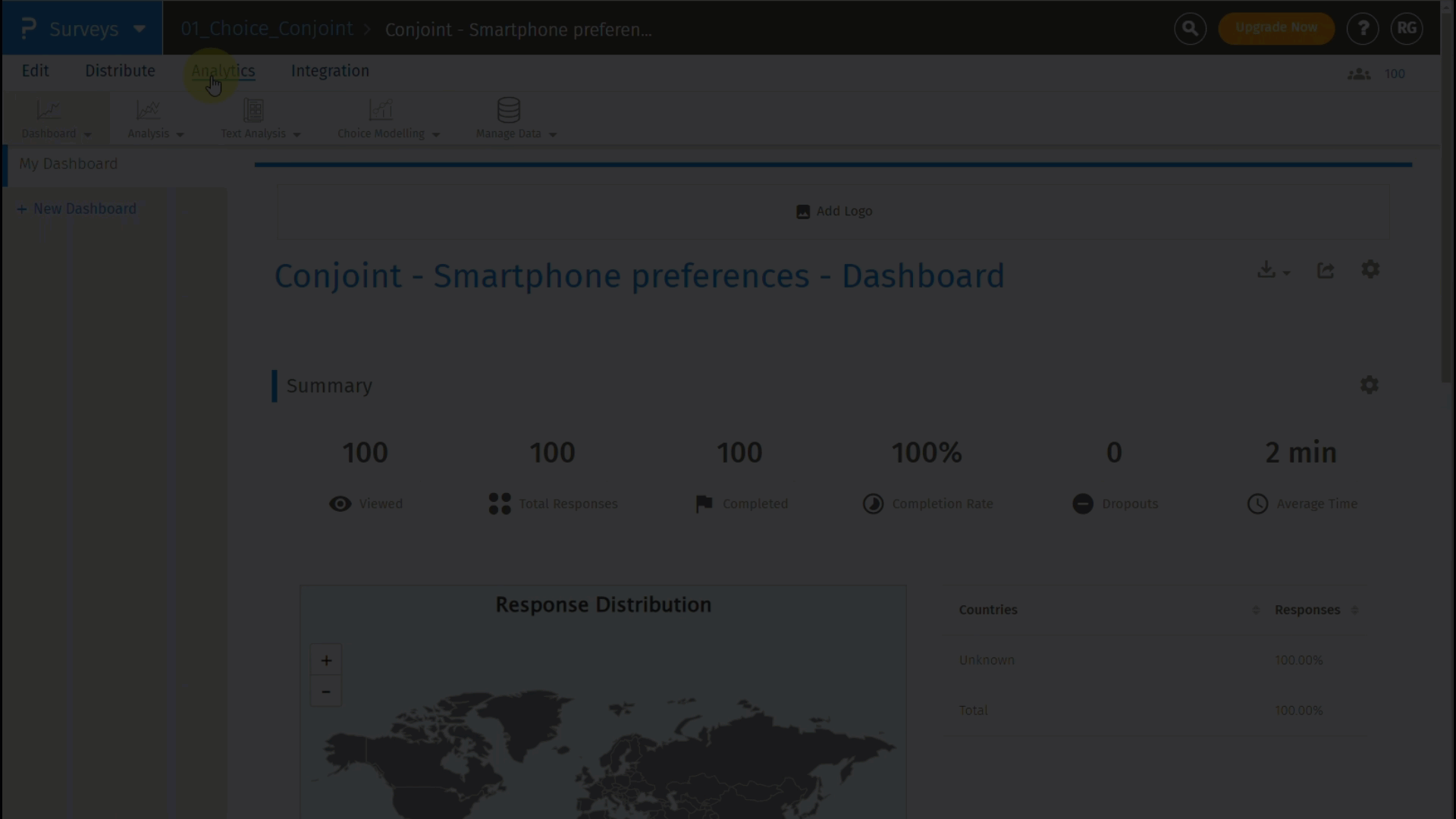 Click to download video
Click to download video
Click on Analytics
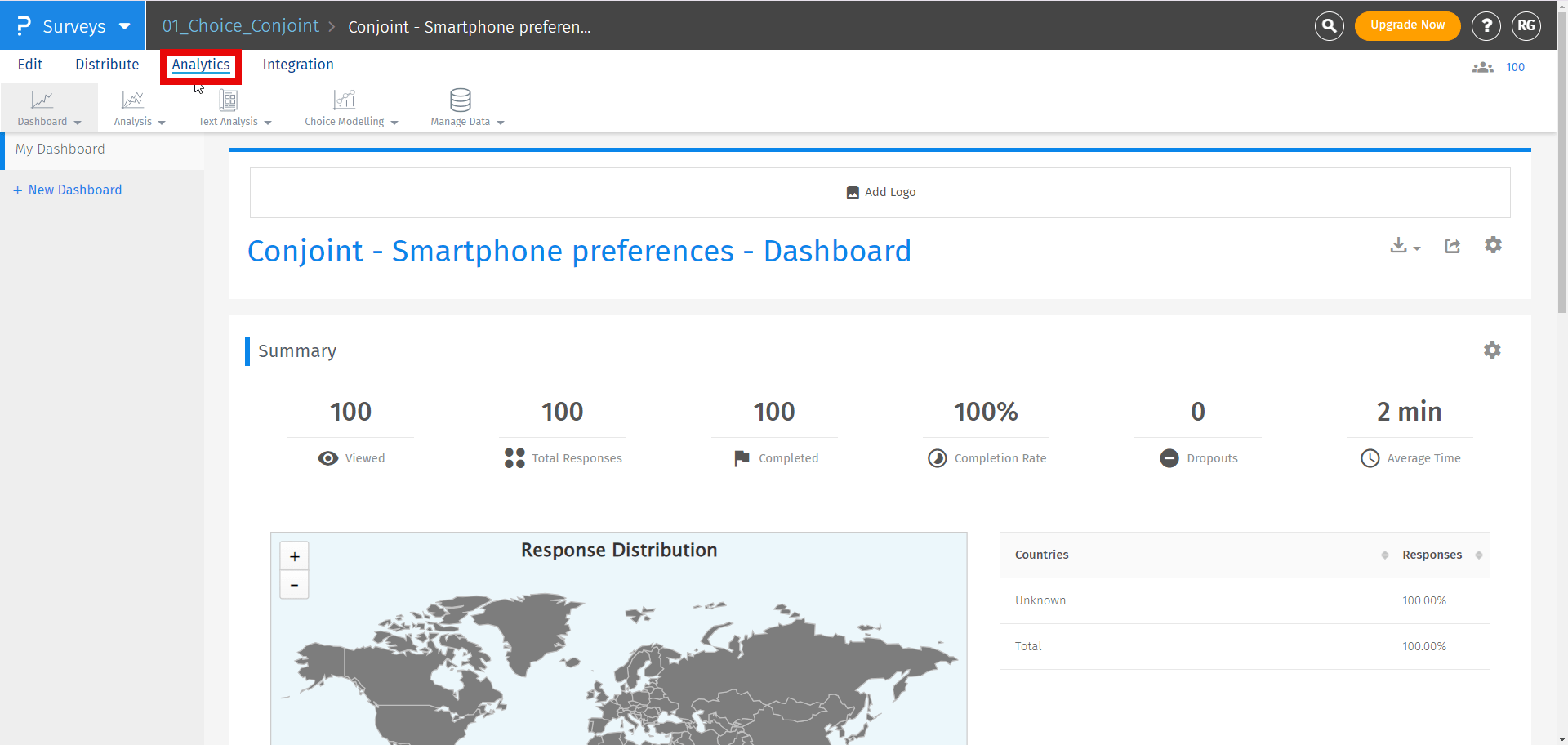 Go To: Choice Modelling » Conjoint Analysis
Go To: Choice Modelling » Conjoint Analysis
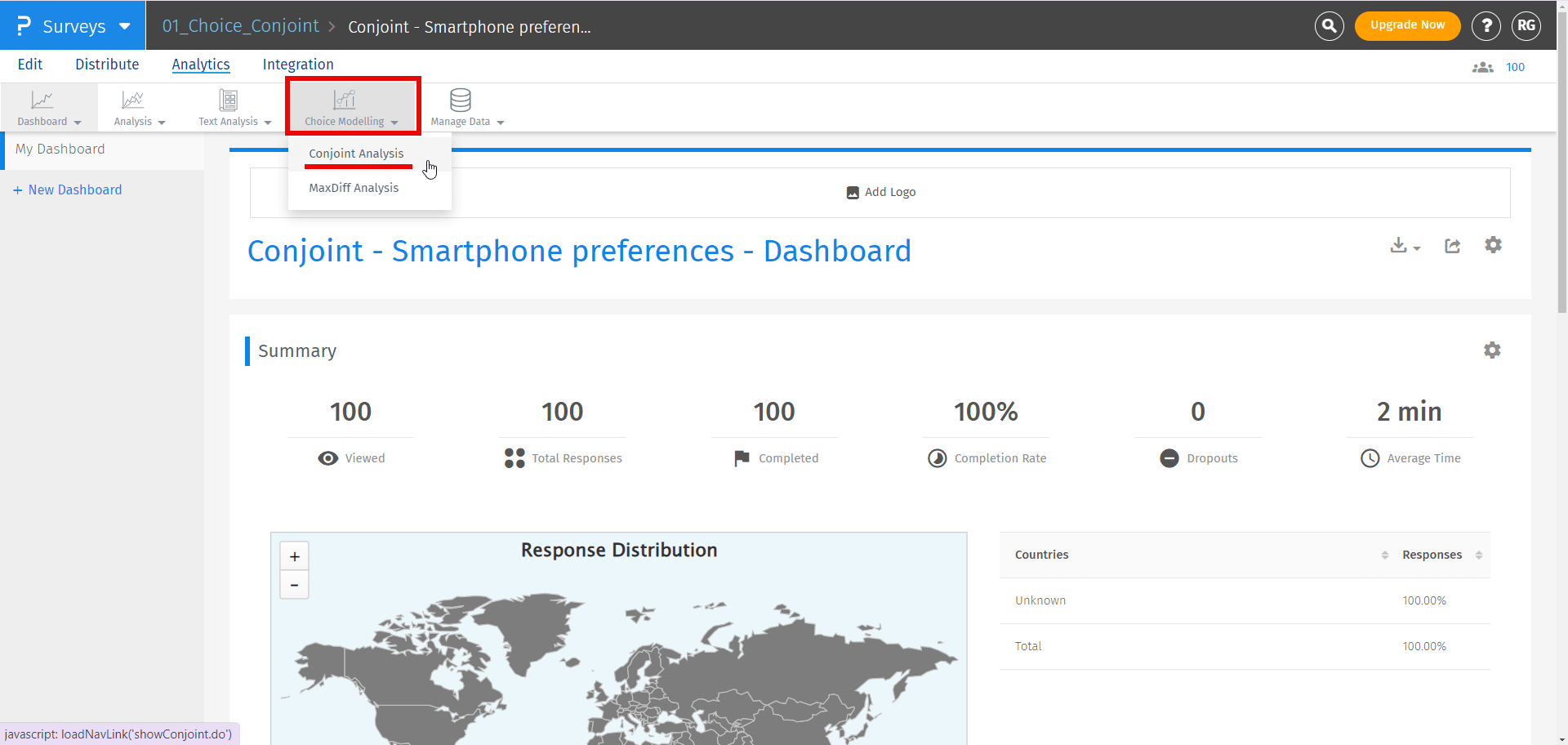 Select the question for which analysis is required and click on Next Step
Select the question for which analysis is required and click on Next Step
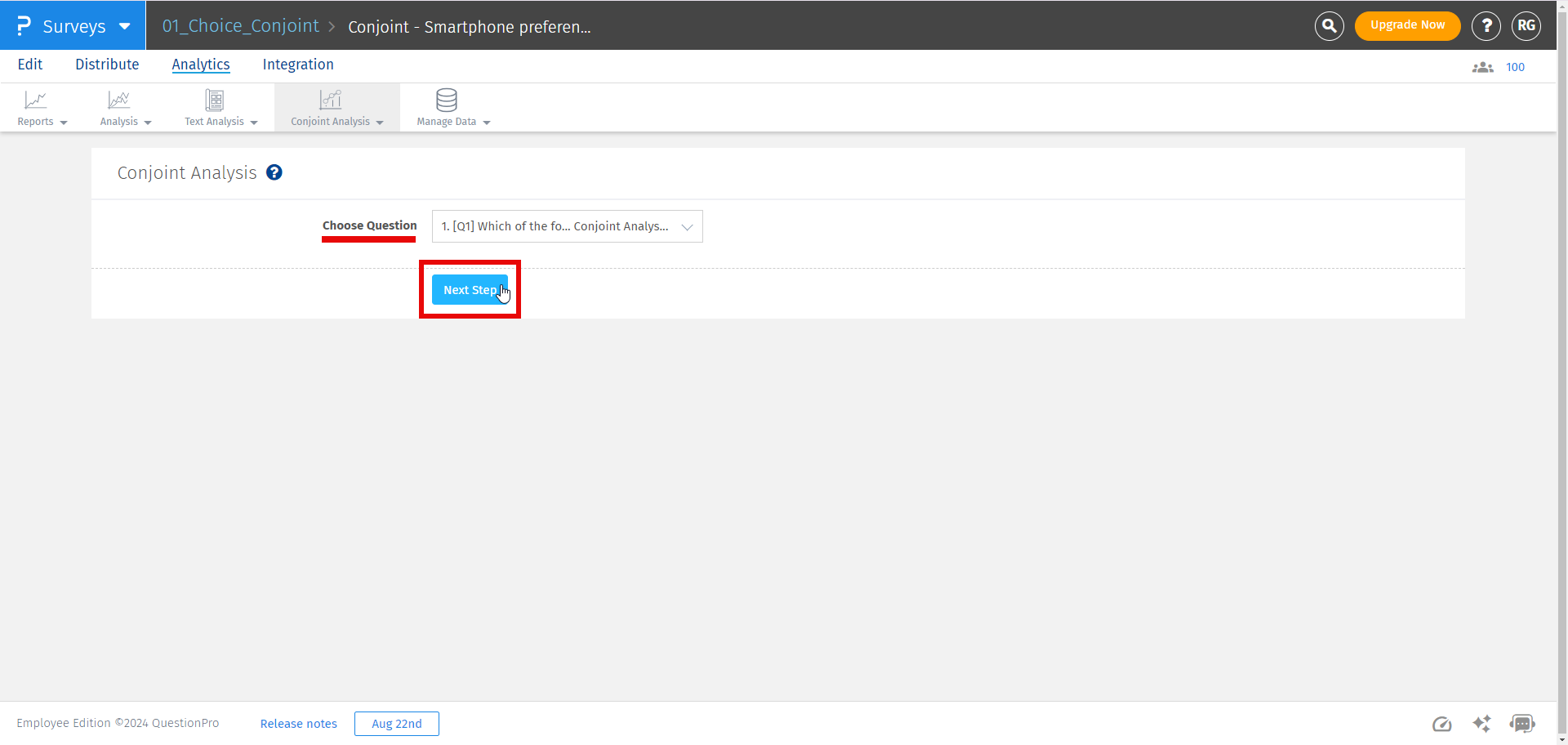 Attribute Importance analysis will be displayed by default as shown below:
Here Importance of each Feature will be calculated and next to which Levelswill be displayed with their individual utility values
Attribute Importance analysis will be displayed by default as shown below:
Here Importance of each Feature will be calculated and next to which Levelswill be displayed with their individual utility values
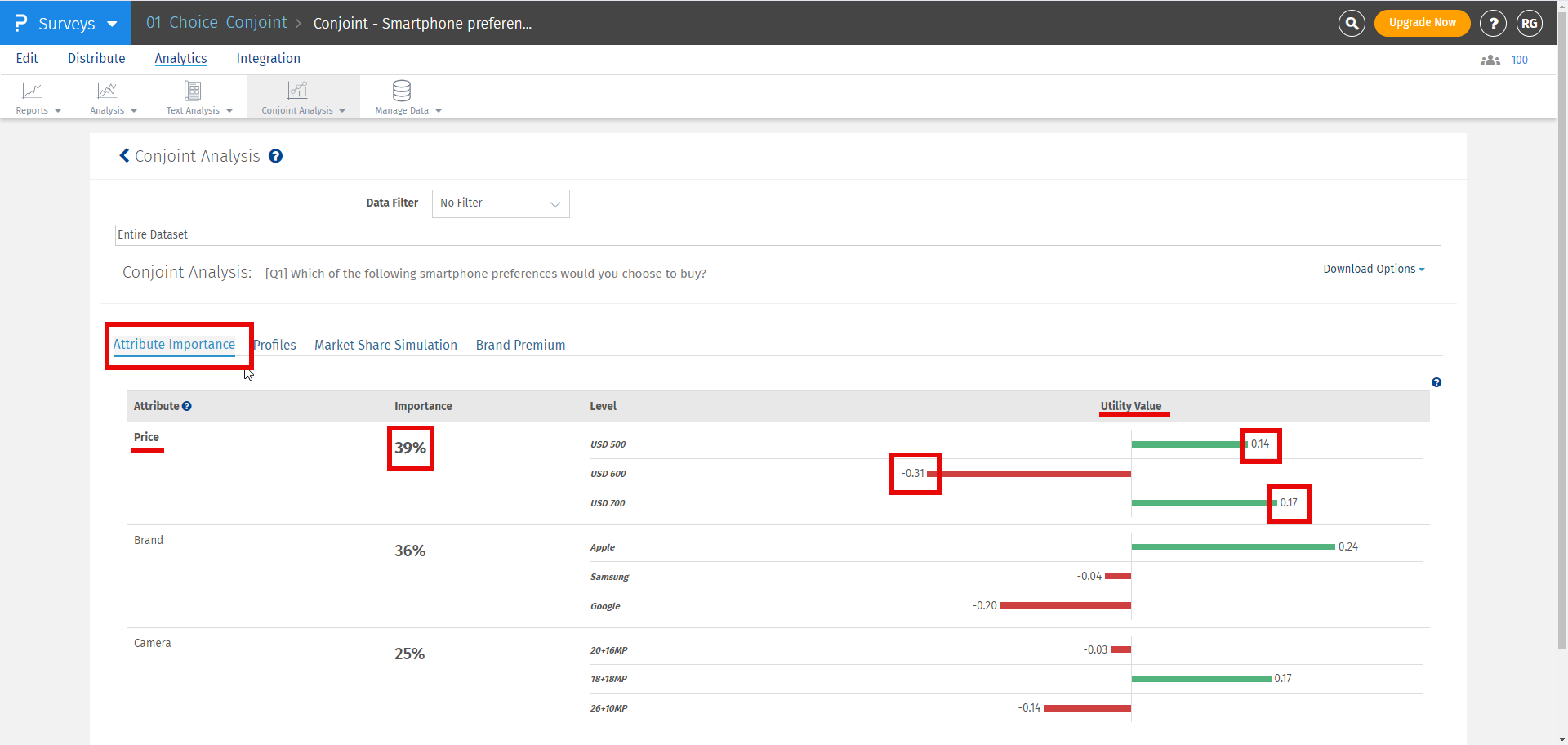
Sometimes we want to characterize the relative importance of each attribute. We can do this by considering how much difference each attribute could make in the total utility of a product. That difference is the range in the attribute’s utility values.
Importance measures are ratio-scaled,but they are also relative,study-specific measures. An attribute with an importance of twenty percent is twice as important as an attribute with an importance of ten, given the set of attributes and levels used in the study. That is to say, importance has a meaningful zero point,as do all percentages. But when we compute an attribute’s importance,it is always relative to the other attributes being used in the study. And we can compare one attribute to another in terms of importance within a conjoint study but not across studies featuring different attribute lists.
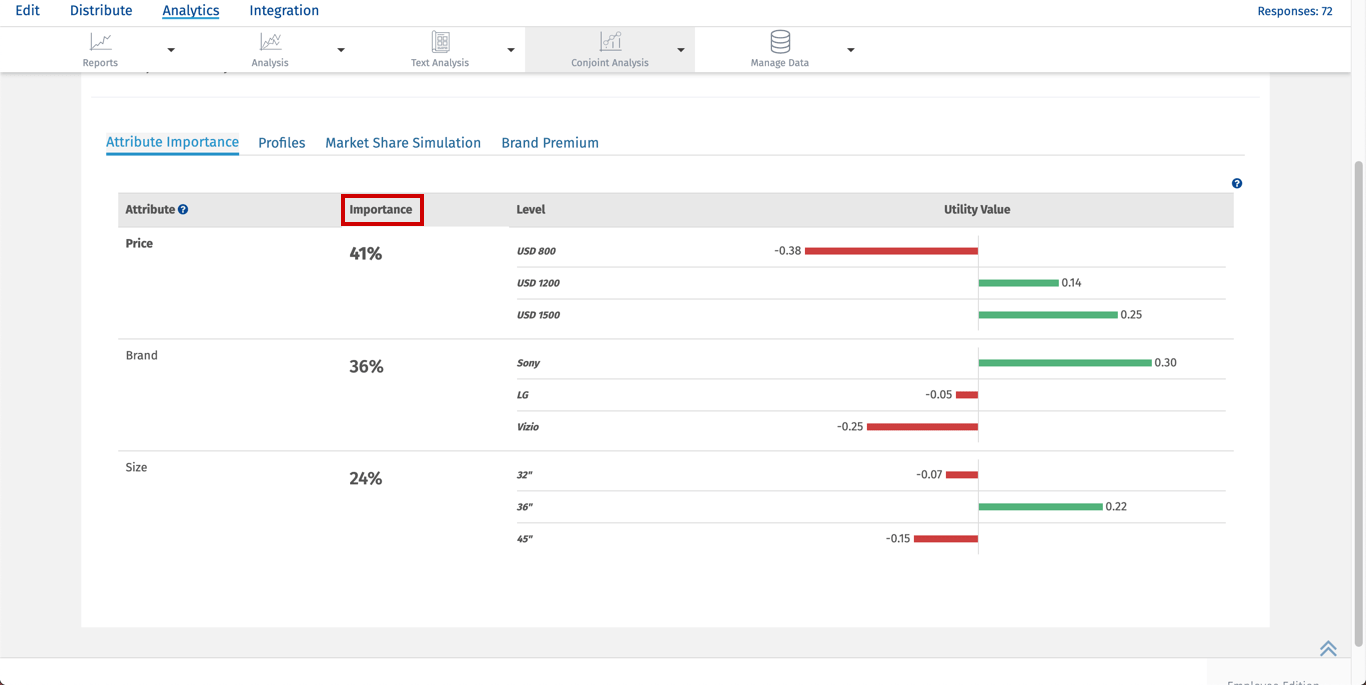
Example:
Step 1: Calculate Attribute Utility Range
Utility Range = Highest Utility Value of an attribute - Lowest Utility Value of an attributeFor Price Range is calculated as 0.25-(-0.38) = 0.63
For Size Range is calculated as 0.30-(-0.25) = 0.55
For Brand Rage is calculated as 0.22-(-0.15) = 0.37
Step 2 : Calculate Total Attribute Utility Range
Total Utility Range = ∑ Utility RangeTotal Attribute Utility Range = 0.63+0.55+0.37 = 1.55
Step 3: Calculating Relative Importance of attributes
Relative Importance of attribute = (Attribute Utility Range/Total Attribute Utility Range)*100Importance of Price = (0.63/1.55)*100 = 40.64% Rounded off to 41%
Importance of Size = (0.55/1.55)*100 = 35.48% Rounded off to 36%
Importance of Brand = (0.37/1.55)*100 =23.87% Rounded off to 24%
Calculating Utility Value
Conjoint utilities or part-worths are scaled to an arbitrary additive constant within each attribute and are interval data. The arbitrary origin of the scaling within each attribute results from dummy coding in the design matrix. We could add a constant to the part-worths for all levels of an attribute or to all attribute levels in the study, and it would not change our interpretation of the findings. When using a specific kind of dummy coding called effects coding, utilities are scaled to sum to zero within each attribute.

Utility Value is calculated using part worth value. For every level of attribute summation of part worth is calculated. Then the average of the summation is taken to get the utility value of a particular level.
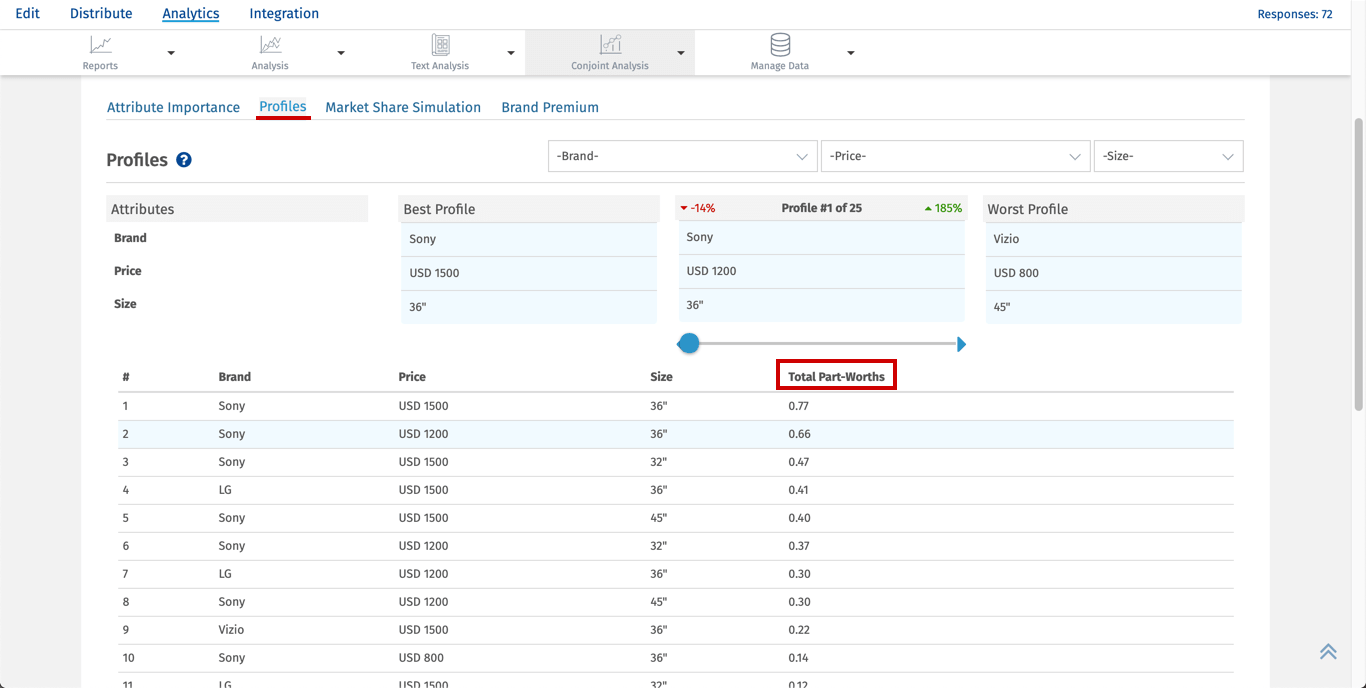
Example: Utility value for USD 1500 is calculated by taking summation of Total part worths for USD 1500 average of which will give utility value.
Summation of total part worths of USD 1500 = 0.77+0.47+0.40+0.41+0.22+0.12+0.05+(-0.08)+(-0.15)=2.21
Average = 2.21/9 which gives utility value of 0.25 for attribute price USD 1500


